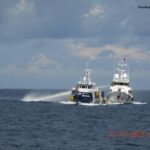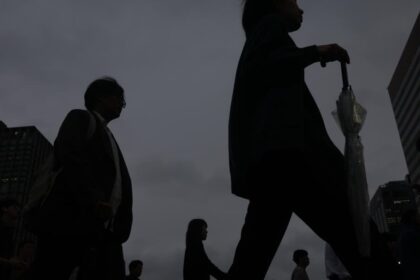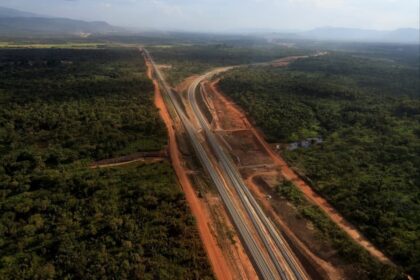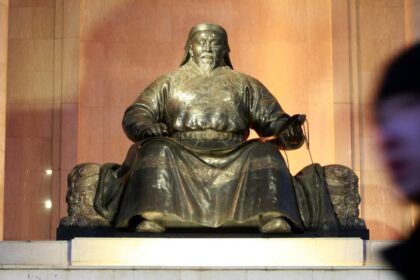Astronauts switch rides after window damage on Shenzhou 20
China brought three astronauts safely back to Earth after an unexpected scare in orbit. Engineers found tiny cracks in the viewport window of the Shenzhou 20 return capsule, damage that mission managers say was most likely caused by a small piece of space debris. Instead of riding home in their own ship, the crew switched to the newly arrived Shenzhou 21 vehicle that had just ferried the next team to the Tiangong space station. The unusual swap a week after the planned departure highlighted how even millimeter scale fragments can threaten human spaceflight.
The trio landed at the Dongfeng landing area in Inner Mongolia at about 3:40 a.m. Eastern on Nov. 14 after 204 days in low Earth orbit. Commander Chen Dong and crewmates Chen Zhongrui and Wang Jie exited the capsule in good condition. Their departure had originally been set for Nov. 5, timed to overlap briefly with the Shenzhou 21 crew that docked on Oct. 31 to start the next six month rotation.
Mission controllers postponed the return once the damage was confirmed and determined that Shenzhou 20 no longer met safety requirements for reentry. The China Manned Space Agency said the spacecraft will remain attached to the station to support on orbit work. The agency plans to send the next ship in the series, Shenzhou 22, at an appropriate time to sustain operations and to restore a standby ride for the new crew.
What happened on Tiangong?
Shenzhou 20 launched on Apr. 24 and served as the crew’s path to orbit, as well as their intended ride home. During routine checks ahead of undocking, teams identified tiny cracks in the glass of a return capsule window. Windows on crewed spacecraft are small on purpose. They allow visual checks of the outside of the vehicle and the environment, but they are areas of relative vulnerability compared with thick pressure hulls and multi layer shielding. Finding even a minor crack prompted a deeper analysis.
A precise threat to a small window
Spacecraft windows are built with redundant panes and protective covers. On many vehicles they combine layers of glass or fused silica, with an inner pressure pane and an outer debris pane. At orbital speeds, a grain sized fragment can carry the energy of a bullet. A crack that appears stable in a calm pressurized environment may grow under heating, vibration, and pressure changes during reentry. Repair in orbit is not practical for a structural window and testing a fix would be impossible before the high stress of descent. That is why engineers treat even small fractures as unacceptable for a crewed return.
Landing and mission achievements
Despite the late change of plan, the mission met its core goals. The astronauts conducted science, maintenance, and outreach across a stay that stretched to nearly seven months. They performed four spacewalks, installing debris shields and external hardware on the station. Coverage showed the crew healthy after landing at Dongfeng. The mission also carried small life science payloads, including mice used to study adaptation to microgravity, which returned for post flight analysis.
Why the crew swapped spacecraft instead of fixing the window
The decision turned on risk. The Shenzhou 20 window cracks were small, but the return profile would have subjected the capsule to aerodynamic heating and large pressure loads. There is no way to certify an in orbit patch for such a critical part. The safer option was to leave Shenzhou 20 docked and send the outgoing crew home in Shenzhou 21, the vehicle that had just brought the next crew to Tiangong.
Program leaders framed the choice around safety. The China Manned Space Engineering Office described its approach as life first, safety first. Keeping Shenzhou 20 aloft also allows engineers to watch how the damage evolves over time, an opportunity to study a real impact in the space environment.
The lifeboat gap and how China plans to close it
With Shenzhou 21 now back on Earth, the current crew on Tiangong temporarily lacks a docked return ship. Human spaceflight programs plan for this scenario. China keeps a Long March 2F rocket and a Shenzhou spacecraft in a high state of readiness at the Jiuquan launch center. In a best case activation, teams can ready an emergency launch in about 8.5 days. The agency has also said it will launch Shenzhou 22 without a crew at an appropriate time, which would restore an on station lifeboat for the new team.
Space debris risk in focus
The incident put a global problem back in the spotlight. Earth orbit contains more than thirty thousand tracked objects larger than ten centimeters, along with many hundreds of thousands of smaller pieces that are too small to track but large enough to damage a spacecraft. Everything in low Earth orbit moves at about 7 to 8 kilometers per second. A tiny shard can pit a window, tear a radiator line, or puncture a thin wall. Operators of Tiangong and the International Space Station routinely fire thrusters to dodge debris that tracking networks predict will pass too close.
Recent history shows how a single strike can reshape a mission. A small object struck the Russian Soyuz MS 22 spacecraft docked to the International Space Station in 2022 and vented its coolant, which added months to the crew’s time in orbit while a fresh vehicle was prepared. NASA’s Frank Rubio reached a United States record 371 days in space in that period. In 2024, two NASA astronauts stayed far longer than planned on the station while their test spacecraft remained under evaluation after thruster issues. Long delays are rare, yet they convey how dynamic conditions in orbit can change a flight plan.
Where debris comes from
Most orbital junk is the legacy of decades of activity. Upper stages have exploded after leftover fuel reacted with oxidizers. Satellites have broken apart as batteries ruptured late in life. Tests of weapons have also created clouds of fragments. In 2007, China destroyed a retired Fengyun 1C weather satellite during an antisatellite test and produced thousands of pieces that still circle Earth. Other destructive events in recent years added their own shards. The common thread is simple. Once a fragment is in a stable orbit, gravity keeps it flying until it slowly falls back into the atmosphere.
What can be done now
Operators can reduce risk by preventing new fragments and by ending missions cleanly. Passivation of batteries and tanks before retirement, lower orbits that decay faster, and disposal burns that deorbit satellites are all part of current guidelines. A widely used practice asks operators to remove satellites from low Earth orbit within 25 years, and some agencies are pushing for shorter timelines. Several groups are testing active cleanup tools, including robotic grapplers, nets, drag sails, and tethers that increase atmospheric drag. These methods show promise in demonstrations, but none is ready to scale to the size of the problem. Better traffic coordination and more precise tracking will also help crews plan safer maneuvers.
China’s space station and ambitions
Tiangong is a three module outpost that reached its basic configuration in 2022. It hosts three astronauts on six month stays and can support six during brief handovers. The station is about one fifth the mass of the International Space Station. Program planners have discussed adding modules as well as a large space telescope that will fly in a nearby orbit for servicing. China has outlined aims to land astronauts on the Moon by around 2030 and has signaled it will welcome international visitors to Tiangong, including a planned flight for a Pakistani astronaut.
Designing for a crowded orbit
Operating a station in a busy orbital lane requires layers of protection and procedures. Tiangong uses shielding to break up small particles before they strike pressure walls. Crews install additional plates during spacewalks as hardware evolves. Regular inspections of sensitive areas, including windows, are part of the routine. Resilience also comes from operations. Keeping a return vehicle docked, maintaining a quick launch rescue capability, and managing supplies to handle short periods with six people on board all build margin into the program.
What is next for Shenzhou 20 and station operations
For now, Shenzhou 20 stays in orbit attached to Tiangong. The agency says it will be used to support on orbit experiments. When its role is complete, controllers are expected to guide it to a controlled reentry over a remote stretch of the ocean, which is the standard way to safely dispose of crew capsules and avoid new debris. Managers will balance that plan with port availability to ensure room for incoming cargo and the uncrewed Shenzhou 22.
Timelines to watch
The key milestones are the uncrewed launch and docking of Shenzhou 22 and the eventual deorbit of Shenzhou 20. A successful Shenzhou 22 docking will restore an escape path for the crew now on board. Logistics flights will continue to keep Tiangong stocked with fuel, food, and research supplies. The program keeps an emergency launch option alive in case rapid help is needed.
Voices from the mission
After landing, mission commander Chen Dong reflected on the experience and the reason crews accept the risks that come with spaceflight.
“The path of humanity’s exploration of space is not smooth. It is full of difficulties and challenges, and that is also why we choose to walk this path.”
Program managers also summarized their guiding rule. The China Manned Space Engineering Office described its choices during the episode as life first, safety first.
Key Points
- Shenzhou 20 return capsule suffered tiny cracks in a window, likely from space debris.
- China postponed the planned Nov. 5 return and brought the crew home on Shenzhou 21 on Nov. 14.
- Landing occurred at the Dongfeng site in Inner Mongolia after 204 days in orbit.
- Shenzhou 20 remains attached to Tiangong to support in orbit work and will be deorbited later.
- Tiangong temporarily has no docked lifeboat. An uncrewed Shenzhou 22 will be launched to restore one.
- The case highlights the growing hazard from small debris that cannot be tracked.
- China aims to expand Tiangong and maintain continuous occupation while pursuing a lunar landing goal.












